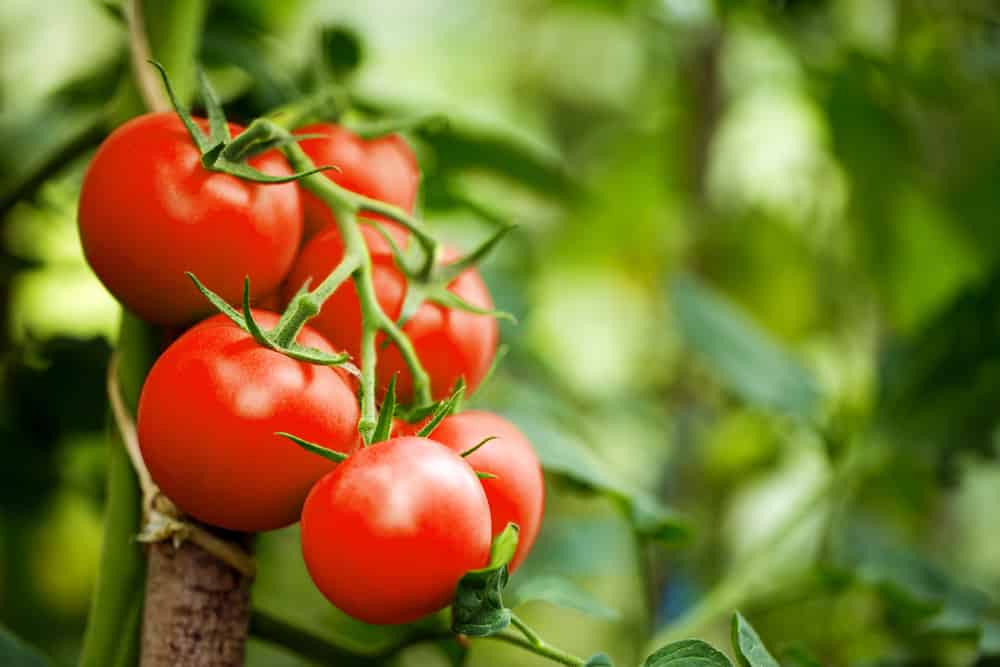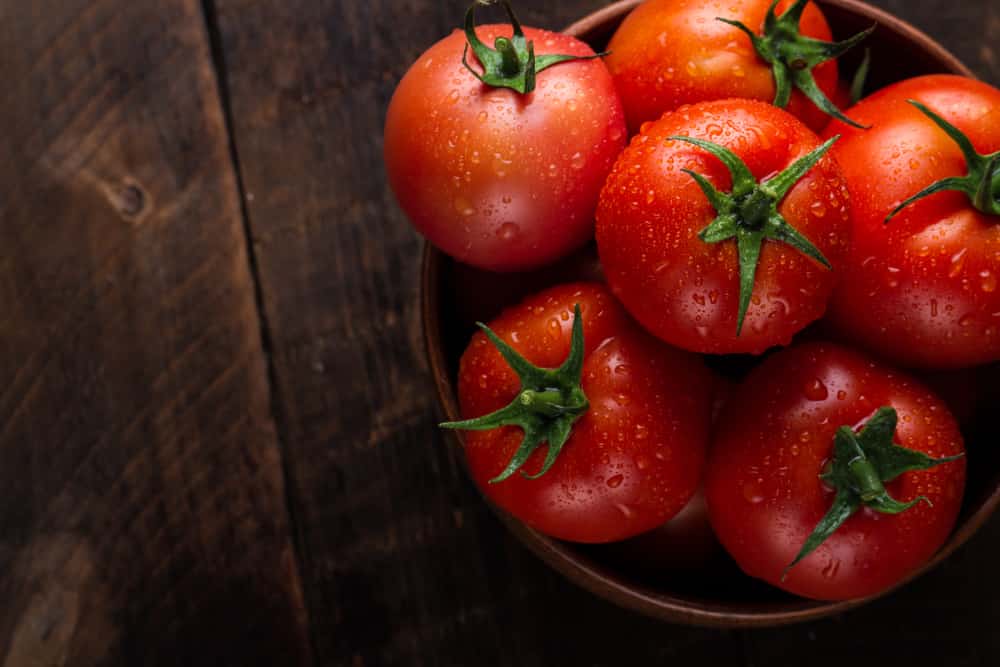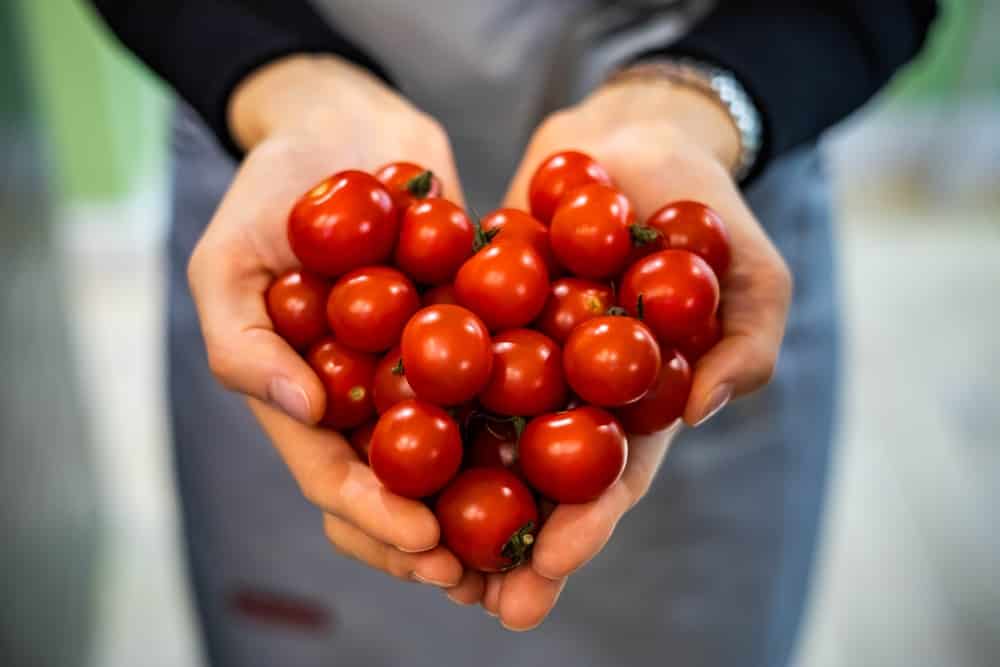
In the heart of Georgia, a sunlit garden reveals ripe tomatoes that eagerly await their harvest.
©eugenegurkov/Shutterstock.com
Ah, Georgia! Land of the sweetest peaches, melodious country tunes, and warm southern hospitality. But wait, there’s more to this charming state than just peaches. Ever bitten into a juicy, sun-ripened tomato fresh off the vine? If not, you’re in for a treat!
Georgia’s unique climate and fertile soil create the perfect backdrop for growing tomatoes – some of the most flavorful you’ll ever taste. From the bustling farmers’ markets of Atlanta to the serene gardens of Savannah, tomatoes are making a grand appearance.
So, whether you’re a seasoned gardener or just someone with a tomato-loving heart, come along! Let’s embark on a delightful journey into the world of growing tomatoes in the heart of the South.

Freshly harvested tomatoes fill a bowl, each shimmering with droplets of water.
©goffkein.pro/Shutterstock.com
Why Georgia? A Tomato Lover’s Paradise
When you think of Georgia, perhaps the first thing that comes to mind is its iconic peaches or the soulful melodies of Ray Charles. But there’s another star in town that deserves its moment in the spotlight: the humble tomato.
So, what is it about Georgia that makes it such a haven for these red, juicy delights?
Climate Advantages: A Tomato’s Dream Vacation
Imagine if tomatoes could choose their favorite vacation spot. Georgia would be at the top of their list! The state’s warm and humid climate is akin to a five-star spa retreat for these plants. With its generous summers that seem to stretch on forever and the gentle embrace of its mild winters, tomatoes get the luxury of time. Time to sprout, flourish, and ripen to a luscious red. Those sun-kissed tomatoes you savored at last summer’s BBQ? You can bet Georgia’s golden sun had a role to play in that unforgettable taste.
Soil Composition: The Perfect Bed for Tomatoes
But it’s not just the climate that’s wooing tomatoes to Georgia. The state’s soil is like the coziest, most nurturing bed you can think of. Packed with nutrients and possessing an excellent drainage system, it offers everything a tomato plant could wish for. And for those of you sighing, thinking about the less-than-perfect soil in your backyard, there’s hope! With a sprinkle of compost and a dash of tender loving care, you can transform it into a tomato paradise.
Ideal Timing for Growing Tomatoes: Dance to Nature’s Rhythm
Every seasoned gardener will nod in agreement: timing is the secret sauce of gardening. And tomatoes, with their sensitive nature, demand this even more. So, when’s the golden hour to introduce those seeds to the soil?
Starting Indoors: Giving Them a Cozy Start
Think of this as preschool for tomatoes. Starting them indoors during the tail end of winter not only shields them from the chilly outdoors but also gives them a robust start. It’s like equipping them with armor before they face the world.
Transplanting Outdoors: The Grand Debut
As the days grow longer and the frost bids adieu, your tomato seedlings will be raring to make their grand debut outdoors. Typically, by the time April showers are preparing to bring May flowers, your tomatoes are ready for the big move. Just ensure the last frost has waved goodbye, and then roll out the red carpet for your tomato plants!

Rows of tomato plants thrive in Georgia’s nurturing soil, soaking up the sun’s warmth.
©vlalukinv/Shutterstock.com
Helpful Tips for a Bountiful Harvest: Your Tomato Masterclass
So, you’ve decided to embark on the tomato-growing journey in Georgia, and we couldn’t be more thrilled for you! But let’s face it, while the idea of plucking sun-ripened tomatoes right from your backyard sounds dreamy, the path to that dream can be, well, a tad tricky.
Fear not, dear gardener! We’re here to arm you with some tried-and-true tips that’ll have your neighbors sneaking peeks over the fence, green with envy at your tomato oasis.
1. Choosing the Right Variety: It’s Like Tomato Matchmaking
Just as we all have our unique quirks and preferences, so do tomatoes. While some tomato varieties bask in Georgia’s warm embrace, others might throw a bit of a tantrum.
The key?
Knowing which ones are ready for a long-term relationship with Georgia’s climate. Dive into a bit of tomato matchmaking. Look for varieties that flaunt their heat tolerance and give a cold shoulder to local pests. A little research now can save a lot of heartbreak later.
2. Watering Techniques: Quenching Their Thirst Just Right
Imagine sipping on a refreshing drink on a hot day. That’s precisely how tomatoes feel about water. But here’s the catch: they like their drinks just right. Not too little, not too much. Deep, consistent watering ensures they get that perfect sip every time. And if you’re wondering about the best time for this hydration session, aim for the early morning. It’s like serving them a revitalizing breakfast before the sun turns up the heat.
3. Fertilizing: The Tomato Gourmet Meal
Think of fertilizing as whipping up a gourmet meal for your tomatoes. And just like any chef, you’ll want to get the ingredients and proportions spot on. A balanced fertilizer is your go-to here. But remember, moderation is key. It’s like seasoning; it’s always easier to add a bit more later than to deal with an over-seasoned dish.
4. Pest Control: The Tomato Guardians
If there’s one thing that can dampen a gardener’s spirit, it’s pests. Those tiny, uninvited guests that fancy a tomato feast. But before you declare war, know that nature has your back. Common foes like hornworms and aphids? They’re no match for nature’s superheroes like ladybugs. So, keep an eye out, foster these natural allies, and watch them guard your precious tomatoes like the treasures they are.
5. Staking and Support: Give ’em a Helping Hand
Tomatoes, especially when laden with fruit, can get a bit, well, droopy. It’s like they’ve had a long day and just want to lie down. Enter stakes and cages. These tools act like a trusty friend, offering a shoulder (or a rod) for your tomatoes to lean on. Not only does this keep your tomatoes off the ground (and away from pests), but it also ensures they get all the sun they crave.
6. Pruning: A Little Snip-Snip for Bigger Fruits
Think of pruning as giving your tomato plants a trendy haircut. By snipping away the lower leaves, especially those touching the ground, you’re reducing the risk of disease. Plus, with fewer leaves to feed, your plant can channel more energy into producing bigger, juicier tomatoes. It’s a win-win!
7. Mulching: The Tomato Blanket
Mulch acts like a cozy blanket for your tomato plants. It keeps the soil cool, retains moisture, and prevents those pesky weeds from crashing the tomato party. Whether you opt for straw, leaves, or compost, a good layer of mulch can be the unsung hero of your tomato garden.
8. Rotation Planting: Keep ’em Guessing
Planting tomatoes in the same spot year after year is a bit like eating the same meal every day. Boring, right? Plus, it can lead to soil-borne diseases. By rotating where you plant your tomatoes, you’re giving the soil a break and keeping potential diseases at bay.
9. Taste Test: The Ultimate Reward
This might sound obvious, but don’t forget to taste your tomatoes regularly! Each variety has its peak flavor moment. By sampling them now and then, you’ll know exactly when they’re at their lip-smacking best. After all, isn’t that the whole point of this gardening adventure?
10. Companion Planting: The Tomato’s BFFs
Here’s a little secret from the gardening world: tomatoes, like us, have their favorite companions. And no, we’re not talking about mozzarella and basil, though that’s a delicious combo! We’re talking about companion plants. These are plants that, when grown near tomatoes, can boost their growth, deter pests, or simply help them feel more at home.
For instance, marigolds are like the tomato’s bodyguards. Their scent deters nematodes and other pests. Basil, on the other hand, is like the tomato’s BFF. Growing them side by side not only enhances the flavor of your tomatoes but also keeps away pesky flies and mosquitoes. And let’s not forget about nasturtiums. These vibrant flowers act as a trap crop for aphids, drawing them away from your precious tomatoes.

A hand cradles sun-kissed tomatoes, freshly picked and ready to eat.
©Kostikova Natalia/Shutterstock.com
Common Mistakes When Growing Tomatoes: Navigating the Minefield
Ah, the joys of gardening! It’s a dance of nature, where every step counts. But let’s be real, even the most graceful dancers can sometimes trip over their own feet. Growing tomatoes is no different. Whether you’re a newbie or have been at it for years, pitfalls are waiting to catch you off guard. Let’s shine a light on some of these and ensure your tomato journey is smooth sailing.
Overwatering: The Tomato’s Cry for Moderation
Tomatoes, like us after a hearty meal, love a good drink. But there’s a fine line between quenching their thirst and making them feel like they’re in a never-ending rainstorm. Overwatering can leave your plants susceptible to diseases and, ironically, thirsty for nutrients.
The trick?
Listen to the soil. If it feels dry about two inches down, it’s time to bring out the watering can. And remember, it’s quality over quantity. Deep, infrequent watering is the way to go.
Planting Too Close Together: The Tomato Claustrophobia
Imagine being at a concert, squished between fans, barely able to breathe. That’s how tomatoes feel when planted too close together. They crave their personal space. Crowding them can stifle air circulation, making them more vulnerable to diseases. Plus, they’ll compete for nutrients, leading to a lackluster harvest.
Why Spacing Matters: The Tomato Comfort Zone
To put it simply, would you like being stuck in a jam-packed elevator, especially on a sweltering day? Probably not. Tomatoes feel the same. Giving them ample space is like booking them a room in a luxury resort. They’ll reward you with robust growth, fewer diseases, and a bountiful harvest.
Ignoring Soil pH: The Tomato’s Preferred Playground
Tomatoes aren’t too fussy, but they do have a preferred playground when it comes to soil pH. They thrive in slightly acidic soil, with a pH level of 6.2 to 6.8. Ignoring this can lead to nutrient deficiencies and poor fruit development. A simple soil test can guide you in making any necessary adjustments.
Neglecting Sunlight: The Tomato Sunbath
Tomatoes adore the sun. It’s their version of a beach vacation. Planting them in shady spots is like sending them to a gloomy, rainy locale. Ensure they get at least 6-8 hours of direct sunlight. If your garden is a bit on the shady side, consider growing smaller varieties that can make do with a bit less sun.
Forgetting to Harden Off: The Tomato Boot Camp
Tomatoes started indoors can be a bit pampered. Before introducing them to the great outdoors, they need a transition period, a kind of boot camp. This process called hardening off, involves gradually exposing them to outdoor conditions over a week. Skipping this step can shock them, leading to stunted growth.
In the end, remember that gardening is as much about learning as it is about growing. Every mistake is a lesson, and every challenge is an opportunity. With these tips in hand, you’re well on your way to a tomato harvest that’s the stuff of legends.

On display is a mesmerizing palette of tomato varieties, ranging from the deepest reds to the most radiant yellows, a celebration of nature’s spectrum.
©sadecestock/Shutterstock.com
The Tomato Love Affair in Georgia
Ah, the sweet symphony of biting into a ripe, sun-kissed tomato! If there’s one thing Georgia knows how to do right, besides its legendary peaches, it’s growing some darn good tomatoes. The journey of planting, nurturing, and finally harvesting these red jewels in the Georgian soil is nothing short of poetic.
Growing tomatoes in Georgia isn’t just about the end product; it’s about the entire experience. It’s the anticipation of the first sprout, the joy of the first blossom, and the pride of the first fruit. With Georgia’s generous sun, nurturing soil, and unmistakable Southern charm, you’re not just growing a plant; you’re crafting a story, a summer-long romance.
So, if you’ve been on the fence about diving into the world of tomato gardening in Georgia, here’s your sign. Take the plunge. Get your hands a little dirty, sing to your plants, and watch them sway and grow. By summer’s end, as you savor the fruits of your labor, you’ll realize it was all worth it. And trust us, once you’ve tasted a homegrown Georgian tomato, there’s no going back. Your taste buds—and your heart—will be forever grateful.

After growing tomatoes, fresh soup in a bowl marks the fruits of hard-earned labor.
©nadianb/Shutterstock.com
FAQs: Your Tomato Queries, Answered!
Ah, the world of tomato gardening! As delightful as it is, it’s also filled with questions, especially when you’re just starting. But fret not, fellow gardener! We’ve got your back. Let’s dive into some of the most burning questions about growing tomatoes in Georgia and unravel the mysteries together.
1. How often should I water my tomato plants?
Great question! Tomatoes, like us after a workout, can get pretty thirsty. But how much is too much? While it largely depends on Mother Nature’s mood, a good rule of thumb is to check the top 2 inches of soil. If it feels like a desert, it’s time to give your plants a drink. If it feels like a damp sponge, maybe wait a day or two.
2. Is growing tomatoes in pots possible?
Absolutely! Not everyone has sprawling gardens, and that’s okay. Tomatoes are pretty adaptable. Just make sure you pick a spacious pot with good drainage. Think of it as giving your tomato plant a comfy apartment with a great view!
3. What’s the best variety for growing tomatoes in Georgia?
Ah, the age-old question! Georgia’s warm embrace is loved by many tomato varieties. But if you’re looking for the crème de la crème, ‘Heatmaster’ and ‘Solar Fire’ are like the superheroes of the tomato world in Georgia. They’re built to thrive and flaunt their flavors in the Southern sun.
4. Do I need to stake my tomato plants?
Think of staking as giving your tomatoes a trusty walking stick. As they grow and bear fruit, they can get a bit top-heavy. Staking or caging them is like offering a supportive arm, ensuring they don’t tumble over. Plus, it keeps those precious fruits away from soil-borne diseases.
5. Why are my tomato leaves turning yellow?
Oh, the colorful drama of tomato leaves! Yellowing can be a sign of a few things. Maybe they’ve had a bit too much water, or perhaps they’re craving some nutrients. It could also be a sign of certain diseases. It’s like your plant’s way of sending an SOS. Check the soil’s moisture, ensure you’re feeding them right, and keep an eye out for any other symptoms.
Remember, every tomato plant, like every human, is unique. They have their quirks, their joys, and their little tantrums. But with a bit of love, care, and understanding, you’ll both be on your way to a beautiful, fruitful relationship!
The photo featured at the top of this post is © Kostikova Natalia/Shutterstock.com
Thank you for reading! Have some feedback for us? Contact the AZ Animals editorial team.







